Do you want to add the 11th chords to your playing repertoire?
You can color up and create new variations in your music by familiarising yourself with the music theory behind their formation, their chord shape, and the alteration possibilities.
This article covers all three types of the 11th chords – the major, minor, and dominant. This is followed by the b11 and #11 alterations on these basic extended chords and how to play them on your guitar fretboard.
Read the complete article to know all the important stuff about the 11th chords on the guitar!
How to build the 11th Chords?
The extended chords are built by extending the 7th chords by up to three intervals. The name extended chord implies the highest note is more than one octave away from the root note, even in the root position of the chord.
An 11th chord features two extensions beyond the basic 7th chord notes. The purpose of these chords is to increase the tension, dissonance & color further, as all chords beyond the basic triads are dissonant in nature.
Types, Notes & Notations of the Eleventh Chords
All extended chords (9th, 11th, and 13th) have only three sonorities or qualities – Major, Minor, and Dominant. In addition, the intervals of the extensions from the root notes are the same for all three qualities. The fundamental difference lies in the first four notes, i.e., the 7th chord notes. Hence these 4 notes are frequently referred to as the chord tones and balance as extensions.
These 3 types of chords can be chromatically modified to form what is known as altered chords. Let us briefly go through the structure, notes, and notations of all the variations of the 11th chords.
Major Eleventh Chords
Take a Major seventh chord. Add two intervals of a minor third over it. You will get a Major 11 chord. The 11th note is a Perfect 11th or a Perfect 4th interval from the root of the chord. This is true for all the 3 types of extended unaltered chords.
Major 11 chord has a chord formula [1 3 5 7 9 11]. Hence, the notes of the CMaj11 or C Major 11 chord will be {C, E, G, B, D, F}.
Minor Eleventh Chords
A Minor 11 chord is formed by stacking a minor 3rd (m3) interval over the minor 9th chord or intervals of major 3rd (M3) followed by minor 3rd (m3) over the corresponding minor seventh chord.
It has a chord formula [1 b3 5 b7 9 11]. Hence, the notes of the C minor 11 or Cm11 chord will be {C, Eb, G, Bb, D, F}.
Dominant Eleventh Chords
The dominant eleventh chord has a minor 3rd interval over the dominant 9th chord or (M3 + m3) over the corresponding dominant 7th chord.
The Dominant 11th has the chord formula [1 3 5 b7 9 11]. This makes the notes of the C Dominant 11, or C11 chord, to be {C, E, G, Bb, D, F}.
The table below gives the summary of intervals and notes of the basic 11 chords.
Issues with the Eleventh Chords
All the 11th major and dominant chords have a P11 or P4 interval. These chords also have a major 3rd, just a half step below P4. There is a chance of a clash in these notes and an unpleasant sound. Hence, you can either,
- Remove the 3rd. This results in a suspended chord, where a 3rd is replaced by a 4th like a Major7sus11: [1, 5, 7, 11]. Or,
- Play a #11 instead of the P11. It is then an altered chord, which we will discuss later.
Altered 11th chords
As stated earlier, the altered chords are formed by raising up or down the notes of any chord by a semitone. To build an altered 11 chord, you must raise or lower the 11th note (b11 or #11) of the corresponding major, minor or dominant chord. So the 11th note will not be in the respective keys.
Altered 11th Major Chord
By altering the Major 11th chords, you get:
- The #11 variation: The chord is named Maj9#11. CMaj9(#11), in the key of the C major scale, has the notes C, E, G, B, D, F#.
Altered 11th Minor Chord
By altering the Minor 11th chords, you get:
- The b11 variation: Note that this chord also has both Major and minor 3rd notes and is denoted as m9b11. The notes of Cm9b11 are C, Eb, G, Bb, D, and E.
- The #11 variation: The chord is called m9#11, with the notes of Cm9#11 being C, Eb, G, Bb, D, and F#.
Altered 11th Dominant Chord
By altering the Dominant 11th chords, you get:
- The #11 variation: The chord has the name 9#11. C9#11 carries the notes C, E, G, Bb, D, and F#.
Add 11 Chords
The added tone chords are formed from the corresponding seventh chords by leaving out the seventh note and adding other tones.
If the added tone is the Perfect 11th, you get the add11 chords. The chord formula for these chords is add11 [1, 3, 5, 11] with intervals {R, M3, P5, M11}. In the key of C, Cadd11: [C, E, G, F].
Add 11 on the 9th Chord.
You can use the concept on other chords as well. For example, if you add the P11 note to the m7b9 chord, you get an m7b9 (add11) chord with Cm7b9 (add11) having the notes [C Eb G Bb Db F].
By adding the #11 note to the altered dominant 9th chord 7b9, you get the 7b9#11 chord. The C7b9#11 chord has notes [C E G Bb Db F#].
Similarly, the 7#9#11 is formed by adding #11 to the 7#9 chord. The C7#9#11 chord has notes [C E G Bb D# F#].
Songs With 11th Chords
The eleventh chord is used more in Jazz music. Some popular songs using them in their chord progressions are:
- “Sun King” by The Beatles. [C11 Chord]
- “Long & Winding Road” by the Beatles. [Bb 11 chord]
- “Easy” by the Commodores. [Eb11 chord]
- “Good Vibrations” by the Beach Boys. [F11]
Ommission of Notes while Playing 11th chords
The general rules are:
- You can leave the 3rd only if it clashes with the other notes, as we stated above with an example.
- You can leave out the 5th note in most situations.
- It is recommended to play at least 1, 3, 7, and 11 in the 11th chords and leave out the 5th and the 9th notes.
11th Chords on Guitar – Guitar Chord Charts
In this section, you can learn how to play the different types of eleventh chords on your guitar.
Major Eleventh Chord Chart
You can see the different voicings of the Maj 11 chords in the chord diagrams below. You can see the three moveable shapes, which can be used to play all the Maj 11 chords. Each chord is marked with a different color, and the root note is named to identify the chord with a color.
- In the first voicing, the 5th and 9th are omitted, with the root on the 6th string.
- In the second voicing, the 3rd and 5th are omitted, with the root on the 6th string.
- In the third voicing, the 3rd and 5th are omitted, with the root on the 5th string.
Voicing 1

Voicing 2

Voicing 3

Minor Eleventh Chord Chart
For the Minor Eleventh Chord, you can have both open and movable shapes, as shown below.
Open Shapes
Am11
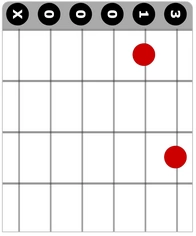
Bm11
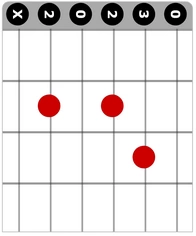
Cm11
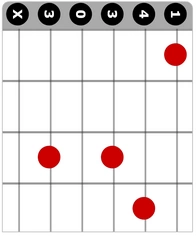
Dm11
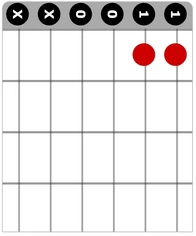
Em11
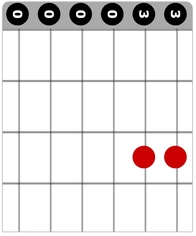
Gm11
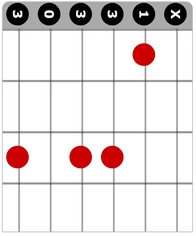
Movable Shapes
In the movable minor 11th chord shapes, you can see the voicings with roots on the 6th, 5th, and 4th strings below. In all these voicings, the 5th and the 9th have been omitted.
Movable Shape 1 – Root At 6th String

Movable Shape 2 – Root At 5th String

Movable Shape 3 – Root At 5th String

Movable Shape 4 – Root At 4th String

Dominant Eleventh Chord Chart
In the dominant 11th movable shapes shown below, the first three shapes have their root notes at the 6th string, while the last two have them at the 5th string.
In shapes 1, 2, and 4, the 5th and 9th notes are omitted, while in the 3rd and the 5th shapes, the 3rd and 5th notes are omitted.
Movable Shape 1 – Root At 6th String

Movable Shape 2 – Root At 6th String

Movable Shape 3 – Root At 6th String

Movable Shape 4 – Root At 5th String

Movable Shape 5 – Root At 5th String

Conclusion
We hope that you found our article on the 11th chords useful. If you have any comments or want further clarifications, you can write to us in the comments section below.
